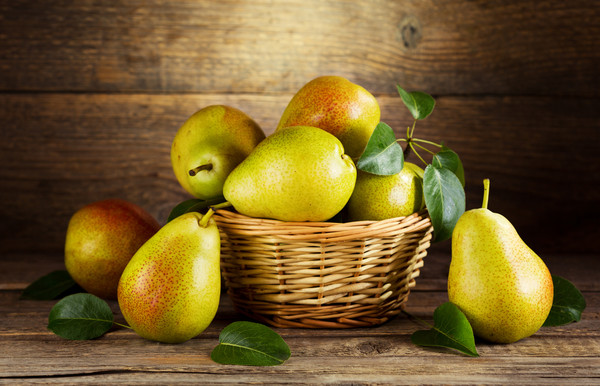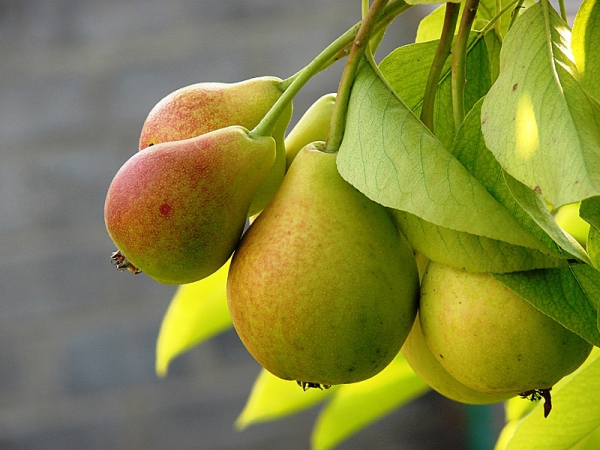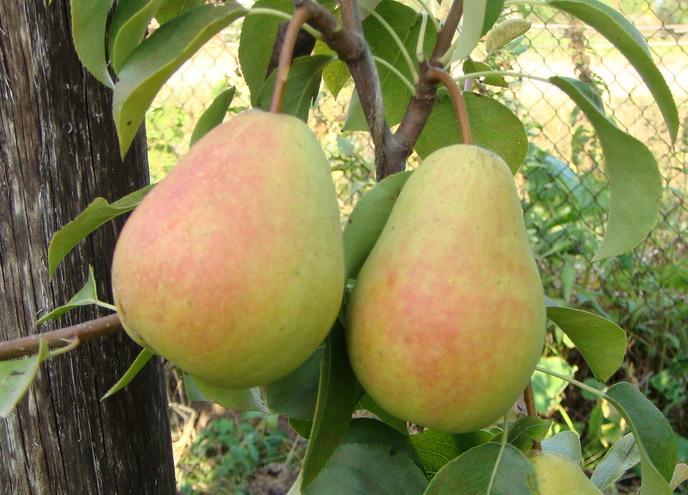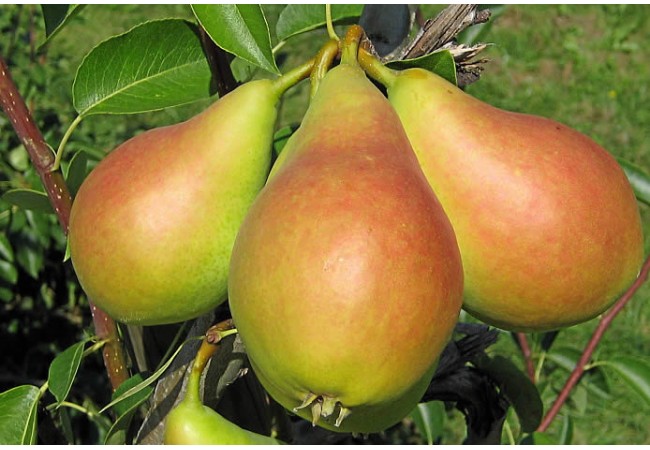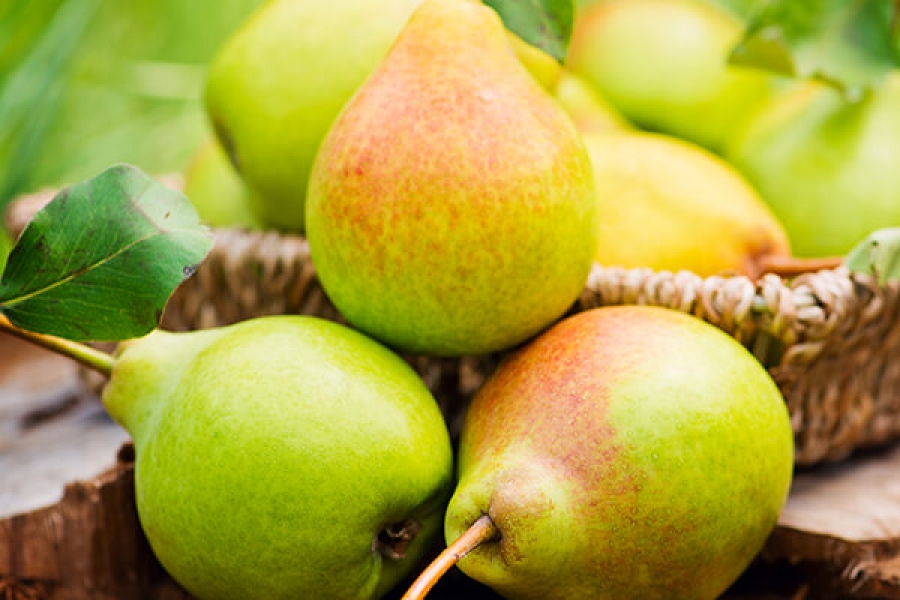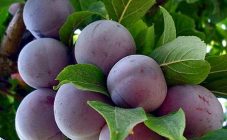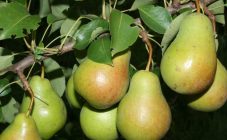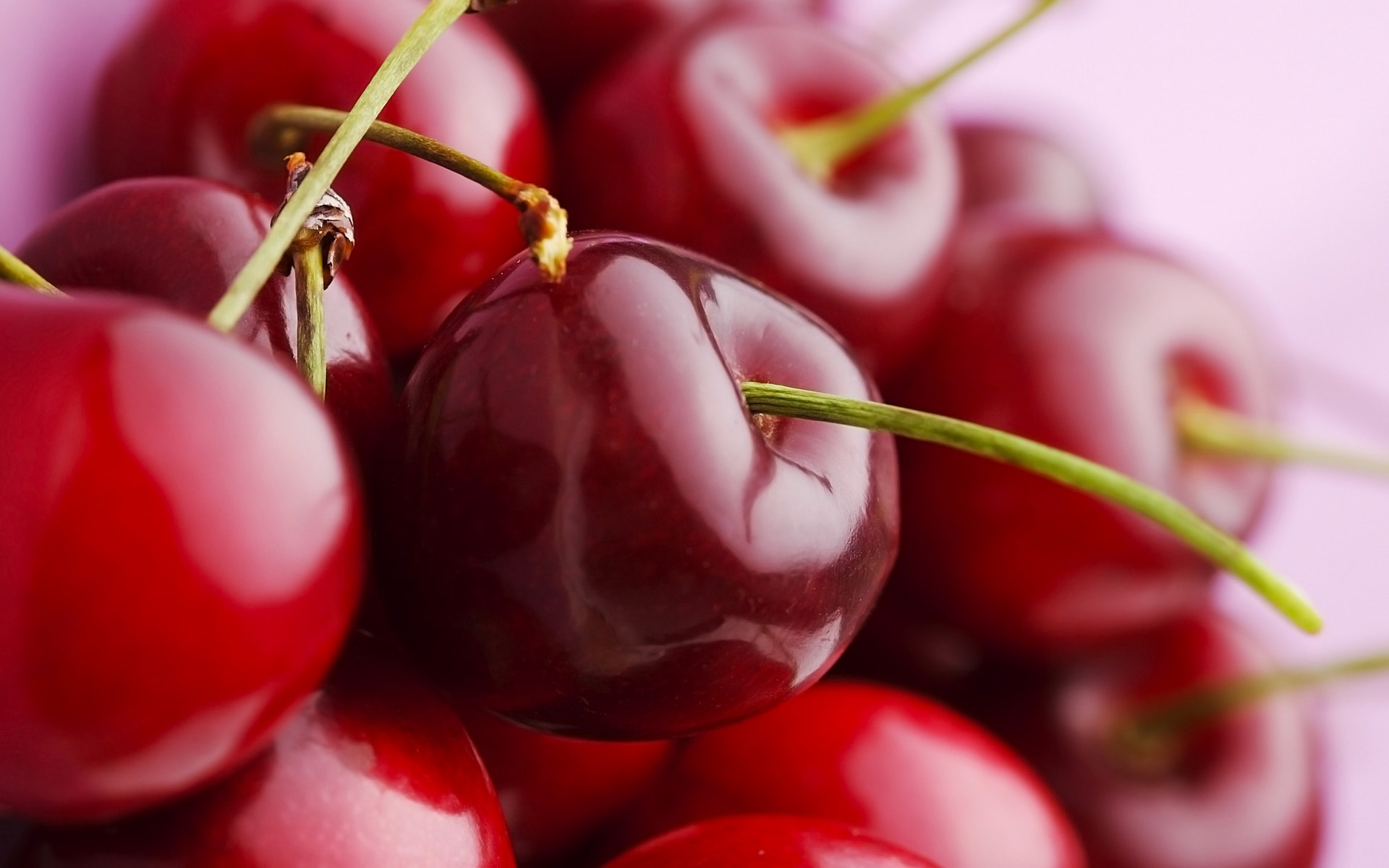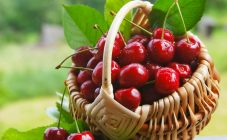Content:
Not only tasty, but also very useful for health is such a fruit as a pear. The fruit is rich in vitamins: B9, B1, B2, PP, C, P, E, pectin and tannins. Such fruits can not only be consumed raw, but also pickled, dried for the winter, prepared from them compotes, jams, marmalades, various desserts and sweets. The pear is ideal for sweet pastries and original second courses, snacks.
Pear and features of its cultivation
The pear is a fruit tree that botanists attribute to the Pink family. The delicious pear fruit was described by the ancient Romans. In Europe, this tree began to be actively propagated since the 19th century. As a rule, the pear does not grow higher than 20 meters. The bark and shoots are brownish. The tree usually begins to bloom in May.
Fruit ripening occurs in different ways, depending on the variety. They are harvested from July to November.
For planting pear seedlings, the best option would be a sunny area where the air does not stagnate. The soil should be loose, permeable and rich in trace elements. At the same time, the tree does not tolerate excessive moisture and, as a rule, dies if the groundwater is too close. The root system should be placed deep in the soil, so the planting hole should not be less than 100-120 cm.
It is necessary to plant pear seedlings immediately in a permanent place, since the pear does not like to move. Since the tree usually needs partners for fruiting, several different pear varieties need to be planted nearby, which can provide mutual pollination.
Frost-resistant varieties of pear
Not all varieties of pears are able to withstand the cold equally. Therefore, for the middle zone, Siberia and other territories of Russia with severe winters, frost-resistant varieties should be chosen. Taking into account their rich experience in gardening, Russian farmers made the TOP-10 of the best frost-resistant pear varieties:
- November... The variety was bred back in 1950, but Noyabrskaya proved its frost resistance in 1974, when it began to bear fruit in the Far East. The tree itself is quite tall. Its green-burgundy shoots grow at right angles to the trunk. The fruits are relatively small, but sweet. One fruit, in its classic version, weighs about 60-65 grams. The owners will be able to get the first harvest in about 3-4 years from the moment the seedlings are planted. The variety has good resistance to many plant diseases, including scab. It is densely covered with fruits annually and provides up to 40-60 kg of vegetables from one tree. Noyabrskaya does not pollinate independently, and therefore it will be useful to plant at least one of these varieties near it: Williams, Conference, Hoverla;
- Ussuriyskaya... Strong and durable grade. It is able to withstand sudden changes in temperature, therefore it gives a rich harvest even in the Far East, Siberia and the Urals. The tree has wide crowns and grows to a height of 15 meters. The fruits ripen in mid-August. They keep on a short stalk, but are not large. 5-6 cm is the standard for this pear variety.They have an oblong and rounded shape and can be yellow or green. On the sunny side, there is a noticeable blush on the fruits. The pulp is aromatic and tasty, however, it contains stony cells. With proper care, a tree can live up to 70-80 years;
- Kokinskaya. A medium-sized tree with a wide and pyramid-like crown. The fruit begins to bear in about 4-5 years from the moment of planting. The fruits can be medium or large. On average, one fruit weighs from 105 to 210 grams. The peduncle is long and thick. The skin of the fruit is thin, green in color with a slight blush. The pulp is oily and juicy, delicate creamy color. The fruit tastes sweet, the notes of astringency are completely absent. The variety is self-fertile, but requires correct crown formation during the growth period;
- Severyanka Krasnoshchekaya... Bred back in 1959 by the famous breeder P.N. Yakovlev for growing in cold areas. The tree has a medium size and medium density crown, outwardly resembles a pyramid. The fruits ripen at the same time. It is recommended to collect them from the tenths of August to the tenths of September. The shape of the fruit is conical, very much like a light bulb. One fruit weighs approximately 80-100 grams. The flesh tastes sweet, but also slightly tart. Farmers estimate the yield as average - 50-70 kg per tree. Fruits are prone to premature abscission, therefore it is important not to miss the harvest period;
- Guidon. Autumn variety of pears. It grows quickly, but not high. The crown is of medium density and resembles a pyramid. Due to the arcuate curved shape of the shoots, it is very convenient to pick fruits from the tree. The fruits are distinguished by the correct classical pear shape. One fruit weighs approximately 110-115 grams. The peel of the pear is smooth, yellow. The pulp is oily and juicy. It tastes sweet and sour. The tasters estimate the variety at 4.2 points out of 5 possible. Guidon begins to benefit from about 4-5 years from the moment of disembarkation. The yield is high. Up to 250 quintals of fruit can be harvested from one hectare of garden;
- Chusovaya... Winter hardy early variety. It was obtained by crossing the varieties: Williams Rouge and Victoria. The tree grows tall - more than 12 m. The crowns are strong and have the shape of a pyramid. Fruits have a thin skin, are yellow-green and red blush. The weight of one fruit reaches 90 grams. The pear variety tastes very sweet, the sourness is almost completely absent. That is why it was awarded a score of 4.3 by the tasters. The advantage of the variety is crisp and fresh pulp, as well as the complete absence of stony. Ripening traditionally takes place at the beginning of September, however, fruits begin to be harvested 10-15 days before that;
- Pink Keg... Refers to varieties of late ripening. You can count on tasty fruits not earlier than September-October. The size and ripening of the fruit is highly dependent on the amount of sunlight received during the summer. The Pink Keg tree does not grow, usually more than 3 meters. The crown has a narrow pyramidal shape. The tree gives fruits at the age of 4-5 years. The fruit is quite large in size (up to 180 grams) and has the shape of a barrel. Outwardly, a pear of a rich pink color. The pulp is juicy and very sweet. There is almost no sourness. At the age of 10, you can get 22 kg of fruit from one tree;
- Pear Cherished... She began to actively reproduce by gardeners relatively recently - since 2002, however, during this period she has already managed to establish herself as a particularly frost-resistant variety. The tree itself is relatively low - up to 10 meters in height. The crowns are dense and rounded. Pear Berezhnaya gives a lot of fruits. The fruit is small in size, weighing approximately 90-120 grams. They are distinguished by a regular ovoid shape and a light yellow color. The pulp is creamy in color, buttery type. Stony particles are almost completely absent. The taste of the fruit is sweet and sour. The tree is durable, can be pollinated by most other varieties;
- Sultan... A relatively new invention of domestic breeders.It has been put into active use since 2011. The tree, although of medium height, however, grows rapidly. The Sultan's fruits are large: one fruit weighs approximately 180-190 grams. It has a traditional pear shape, bright orange color with a thick blush on the sunny side. The fruit tastes sweet and sour. Assessment of the tasters of the variety - 4 points. Harvesting can be done in late autumn. It is perfectly preserved until January;
- Flute... A novelty of the Sverdlovsk breeders. A small tree with a wide crown. It can grow and bear fruit even in Siberia and the Urals. Not afraid of sudden changes in temperature. Fruits begin to give in 3-4 years from the moment of planting. Medium fruit - up to 120 grams. As a rule, they have the correct pear-shaped shape, green with an orange blush. The pulp is crispy and contains almost no stony particles. The fruit has a pleasant smell, has a sweet and sour taste and is rated by tasters at 4.2 points. Another advantage of the cultivar is its good resistance to gall mites.
The best varieties for the Volgograd region
The Volgograd region and the region are distinguished by a temperate continental climate. Winters are usually mild here and summers are hot. The average temperature in February is -6 ℃. In summer, thermometer marks rarely rise higher than + 28 ℃. Thus, local gardeners can plant different fruit trees without fear of sudden cold snaps and frosts.
Taking into account the experience of local farmers, it is necessary to indicate the pear varieties that give the best results in the region:
- Rossoshanskaya... A bright representative of the autumn variety. The crown is wide and pyramidal in shape. Medium-sized fruits - up to 170 grams. The surface of the pear is smooth, in the shape of an apple or pear. During the harvest phase, the fruit is bright yellow in color. May look like a half pear or apple. The pulp is tender, homogeneous, creamy. On the tasting scale, the variety gets up to 5 points for its sweet taste. The seedling is unpretentious to the soil, but the best result can be obtained if it is planted in drained soil. Too long moisture is detrimental to the tree;
- Uralochka... The tree grows up to about 5 meters. Branches are released from the trunk at right angles. The tree gives fruits small in size - up to 45 grams. The shape is usually correct, traditional for a pear. At first glance, the fruit may not seem very appetizing: its skin is matte, yellow-green in color, and the surface is rough. Fruits differ in golden color already on the eve of harvest - in mid-September. The pulp is fine-grained. The taste of the fruit is generally sweet, partly tart. A tree cannot pollinate itself on its own, therefore, pears that can cope with this must be planted nearby. Best suited for Uralochka: Age and Povichla;
- Arab... A winter-hardy species characterized by a high and round crown. The fruits are very similar in appearance to an apple. One pear of the variety weighs approximately 90-100 grams. It is recommended to harvest in September. During this period, they will still be immature, green and tough. However, after lying down a little (1-2 weeks), the pears will soften, turn pink, become juicy, sweetish-sour in taste. Arab woman does not require special care. Can be grown in the same way as other undemanding pear varieties;
- Isetskaya... A productive variety, resistant to frost and drought. The tree grows up to medium height, has a spherical crown. The fruits are pear-shaped, medium in size - up to 110 grams. The pulp of the fruit is tender and juicy, very sweet. They are usually harvested in mid-September. The disadvantage of Isetskaya is the short period of fresh fruit storage - up to 2-3 weeks;
- Winter kubarevidny... The tree has a relatively small growth, but it has good frost resistance. According to experts, not only twigs, but also buds can survive in severe frosts. At the same time, the variety is able to withstand long dry periods.The owners will be able to taste the first fruits in about 6-7 years from the moment of planting the tree. As a rule, the pears themselves are quite large, they can weigh up to 200 grams. The color of the fruit is green, but with a blush on some sides. On the palate Winter kubarevidny sweetish-sour. Tasters give this variety 4.3 from 5 possible points in taste. You need to take care of the tree in the same way as for other varieties. The advantage of the variety is scab resistance. Pears can be harvested in October, and they are kept fresh until January.
The varieties are also good for planting in the Volgograd region: Svarog, Otradnenskaya pear, Larinskaya pear, Montal, Lel pear, Pozdnyaya Pavlovskaya, Bessemyanka, Pushkinskaya, Tonkovotka, Lakomka, Sonata, Molodezhny, Seasonal pear.
Imported pear varieties for northern regions
Like domestic, foreign breeders also try to please gardeners and farmers, therefore they are constantly working on breeding the best pear varieties with a special taste, rich yield and good frost resistance. When choosing the best varieties of pears for the northern regions, do not forget about 5 proven foreign varieties of them:
- Olivier de Serre... This is the result of the work of French breeders. The variety was first planted in 1847. The tree has a dense and wide-pyramidal crown. Differs in good resistance to frost, however, has an average yield. Fruits are medium in size, weighing approximately 120-140 grams. The pear variety can be recognized by its grayish-green color and a large number of brown subcutaneous dots. The shape of the fruit is flat-rounded, ribbing is noticeable. Olivier de Serre is a dessert variety. Its flesh is yellow, soft and aromatic;
- Concorde... Bred in 1969 in England. Refers to the varieties of the winter ripening period. You can harvest the fruits at the end of September or already at the beginning of October. Pears do not fall from the tree after ripening. You can try the first fruits from the tree in 1-2 years after planting. The shape of the fruit is oblong. One pear can weigh up to 300 grams. The skin of the fruit is dark green in color with a slight blush. The pulp is white, crispy and sweet. This variety is winter-hardy, can withstand temperatures up to -30 ℃, is not afraid of repeated frosts;
- Erika... A variety known to gardeners since 1983. Bred in the Czech Republic. The advantage of the variety is good frost resistance and relatively good scab resistance. The yield is consistently high. The crown is not dense, spherical in shape. You can harvest the fruits in the second half of October. The peel is yellow-pink, smooth. The shape is traditional for a pear, somewhat asymmetrical. The fruit is fragrant, sweetish wine. It is not difficult to care for the variety, because its branches do not need to be aligned, unbend;
- Amphora... Bred in 1996 in the Czech Republic. Winter hardy variety. The tree is relatively short, but provides a rich harvest. You can pick pears in the second half of September. They are well stored until February. The fruit is bottle-shaped, elongated. By the time it ripens, it is a green pear, over time it becomes straw yellow. The average fruit weight is 200 grams. The taste is bright pear, with sourness. The pulp is crispy;
- Isolde... Imported variety bred in Germany. Differs in average winter hardiness and regular rich productivity. The crown is flat, with strong shoots. Therefore, there is no need to bend back. The variety is early-growing: fruits ripen in early August. The peel is thin. On the sunny side, the fruits get red, on the other - they remain yellow. The pear is large and sweet. The pulp is aromatic and crunchy. Does not require special conditions for fruiting.
The sweetest and most delicious pear varieties
Although it is customary not to argue about tastes, undoubtedly, every gardener is interested in the best varieties of pears with juiciness and sweet taste. Below are the varieties with the highest sugar content:
- Thumbelina... Only in 1998, gardeners began to actively plant Thumbelina.As the name implies, the tree is of short stature. Trees grow slowly, the crowns have a rounded shape, dense at any age. The description of the variety in the scientific literature makes it clear that it is frost-resistant. All fruits ripen, as a rule, at the same time - in mid-September. The pears are particularly tasty. This is a dessert variety. The taste is sweet. There is virtually no sourness. The variety is considered ecological, because the fruits almost never absorb negative substances from the environment. Keeping quality is also very good: fresh up to 100 days;
- Age-old... Moderately growing autumn variety. Fruits begin to bear about 3-4th year. The variety is resistant to frost, as well as to many plant diseases, in particular: scab and fire blight. Productivity is stable annually. The pear is yellow, it has a good presentation. One fruit can weigh 400 grams. The pulp is white, fully ripe. They have a strong aroma and sweet-sour taste. Overripe fruits have a rich sugar taste;
- Tatyana. Refers to autumn varieties. The tree grows quickly, but in adulthood it is spherical and slightly thickened. One fruit can weigh 140-230 grams. The traditional color for the variety is golden yellow. The shape is traditional for the fruit, somewhat asymmetrical. Pear Tatiana is a dessert variety. The pulp is very juicy, with a delicate texture and rich sweet taste. If it's too late to start harvesting, the fruit gets a mealy taste
- Kupava... The result of the work of Russian breeders, bred in 1971. The best breeding region for the variety is the northern one, but farmers from other regions can also count on a rich harvest. Pear Kupava allows you to taste ripe fruits in mid-September. Although the fruits are relatively small - up to 80-100 grams, they still have a fresh sweet and sour taste. The pulp is homogeneous and soft. Kupava is perfect not only for fresh consumption, but also for making various compotes, jam and jam;
- Duchess summer (also called Williams)... The tree grows to a height of 3-5 meters. The crown is quite dense, and the yield is rich. The first fruits can be expected around the 5-6th year from the moment the seedlings are planted. The tree requires careful care and protection from frost. In addition, pollinating pears need to be planted next to it. However, the worries are worth the results. The traditional color that distinguishes this variety is yellow. Fruit shape is traditional for pears. The weight of one fruit during the ripening period can reach 180 grams. This is a variety of sweet dessert pears. The pulp is creamy or white, very juicy. The flesh tastes sweet-wine, with an almond flavor.
Tips for choosing pear varieties
In order to enjoy a rich harvest of pears from their own garden, owners need to choose at least 2 different varieties of pears with different ripening periods. Summer varieties will allow you to taste the first fruits around July-August. Once harvested, you can use these fruits for food. Summer pears cannot lie down for a long time.
Winter and podzimnye varieties bear fruit in the period from September to November. Pears harvested during this period can lie down until mid-winter. Sometimes they are harvested still unripe, they independently reach the desired state already in the storage (cellar or storage room).
When choosing the best variety for your own cultivation, it is imperative to take into account the following characteristics:
- frost resistance;
- disease resistance;
- the need for moisture;
- the need for pollinating neighbors.
Following the agrotechnical rules for planting a tree and having successfully selected varieties, the owners will be able to enjoy juicy, healthy fruits for many years and even decades.
